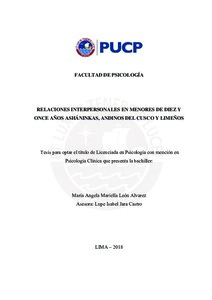Relaciones interpersonales en menores de diez y once años asháninkas, andinos del Cusco y limeños
Abstract
La cultura influye en el desarrollo del ser humano desde el comienzo de la vida. Así, hacia
el final de la niñez, los patrones culturales se encuentran muy internalizados; normando, entre
otros, los modos de relacionarse de los niños. En ese sentido, esta investigación busca
describir y comparar las características de las relaciones interpersonales de menores de diez
y once años asháninkas, andinos y limeños. Para ello se aplicó el Psicodiagnóstico de
Rorschach a 60 menores distribuidos homogéneamente por sexo, edad y lugar de residencia.
Los resultados del clúster de relaciones interpersonales reportan diferencias significativas en
la mayoría de los determinantes; el más significativo es lambda debido al predominio de
respuestas con forma pura en la población asháninka y andina. También se encontró mayor
similitud entre la población asháninka y andina, y mayor diferencia entre la población limeña
y asháninka. Finalmente, se discuten las diferencias significativas entre la data normativa de
Exner y la muestra de estudio, así como entre las tres sub muestras de participantes. Del
mismo modo se señalan los alcances y las limitaciones de la investigación. Culture influences the development of the human being from the beginning of life. Thus,
towards the end of childhood, cultural patterns are very internalized; norman, among others,
the ways of relating of children. In this sense, this research seeks to describe and compare
the characteristics of the interpersonal relationships of children between ten and eleven years
old whom belong to the cultures Asháninka, Andean and Lima. To this end, the Rorschach
Psychodiagnosis was applied to 60 children distributed homogeneously by sex, age and place
of residence. The results of the Interpersonal Relations cluster report significant differences
in most of the determinants; the most significant is lambda due to the predominance of
responses with pure form in the Ashaninka and Andean population. There was also greater
similarity between the Ashaninka and Andean population, and greater difference between the
Lima and Asháninka population. Finally, the significant differences between Exner's
normative data and the study sample, as well as between the three sub samples of participants,
are discussed. In the same way, the scope and limitations of the investigation are indicated.
Key words: interpersonal relationships, culture, Rorschach Psychodiagnosis, ashaninka
Temas
Relaciones interpersonales en niños
Prueba de Rorschach
Cultura
Prueba de Rorschach
Cultura
Para optar el título de
Licenciado en Psicología con mención en Psicología Clínica
Collections
The following license files are associated with this item:






